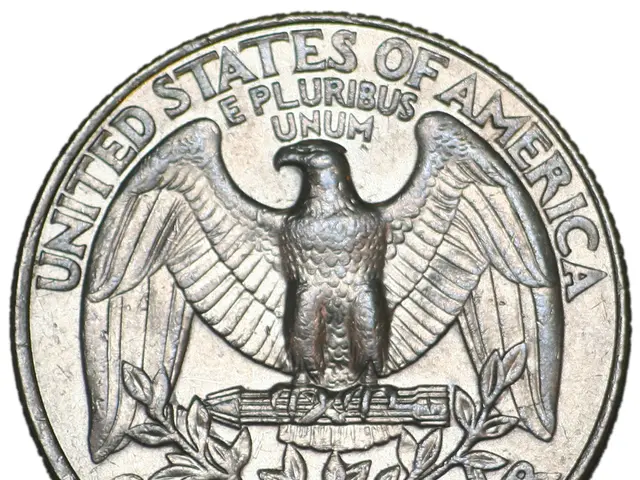Fed Chair Powell Speaks Amid Economic Uncertainty and Stagflation Worries
Central Bank maintains benchmark lending rate in place, navigating through economic turmoil
In a post-meeting address, Federal Reserve Chairman Jerome Powell acknowledges the American economy is in a "solid position," despite soaring uncertainty and potential for stagflation.
The Federal Reserve recently made no changes to its benchmark interest rate, keeping it within the range of 4.25% to 4.5%, as the policymakers carefully monitor economic conditions and inflation. This decision marks the third consecutive meeting where they've chosen a cautious stance.
Notably, this rate decision comes after keeping the benchmark federal funds rate at the same level in January, March, and at their two preceding meetings – following three consecutive rate cuts in September, November, and December.
The Federal Open Market Committee (FOMC) issued a statement noting that economic uncertainty has significantly risen, and they're monitoring risks to both employment and inflation. The FOMC added that the risks of higher unemployment and inflation have indeed risen. However, the labor market remains robust, and inflation lingers somewhat above the 2% long-term objective.
Economic parameters to consider - Net Exports and Inflation
The FOMC pointed out that although net exports have affected recent economic data, growth indicators suggest that activity is continuing to expand at a solid pace. The unemployment rate has stabilized at a low level in recent months, and the labor market remains healthy. Inflation, on the other hand, remains somewhat elevated.
The Federal Reserve's Approach
Powell stated that the economy is in a solid position despite the increased uncertainty. He added that although inflation has significantly decreased, it remains moderately above the desired 2% long-term objective.
Moreover, he expressed concerns about the new administration's policy changes in four specific areas - trade, immigration, fiscal policy, and regulation. The chair stated that the announced tariff increases are considerably larger than anticipated and could generate increased inflation, decelerated economic growth, and higher unemployment.
The effects of these tariffs could be either temporary, causing a mere shift in the price level, or persistent, depending on their magnitude, duration, and the effectiveness of anchoring long-term inflation expectations.
The Dual Mandate - Unemployment and Price Stability
During a question-and-answer session, Powell addressed the potential challenge of the dual mandate – stabilizing both employment and price growth – when faced with stagflation, a phenomenon characterized by higher-than-desirable inflation in conjunction with slow economic growth and potentially a weak labor market.
If the dual mandate objectives come into conflict, the Federal Reserve would have to make a challenging judgment call to maintain a balance. The decision would be based on factors such as how far the economic indicators are from the desired goals, what the expected trajectory will be, and the expected time to return to the goals.
Powell clarified that at present, the economy is not facing this scenario, but the Federal Reserve stands ready to make these tough decisions when necessary.
Economic Clarity Awaited
In response to a question about recent job growth cooling down, Powell indicated that uncertainty about the economy is extremely elevated, and the downside risks have increased. He stated that the Fed would wait for more clarity before taking any further action and added that "usually, things clarify, and the appropriate direction become clear."
Experts predict that the Fed will ultimately hold interest rates steady at its next two meetings, given the solid state of the U.S. economy and the Fed's cautious stance.
In summary, the Federal Reserve is navigating the complexities of its dual mandate within the context of heightened economic uncertainty and the potential for stagflation. To maintain balance, it's maintaining a cautious stance, carefully monitoring economic indicators, and being prepared to react accordingly.
- Fed Chair Powell expressed concerns about the new administration's policy changes in four areas – trade, immigration, fiscal policy, and regulation – and their potential impact on inflation, economic growth, and unemployment.
- The Federal Reserve recently kept its benchmark interest rate, within the range of 4.25% to 4.5%, unchanged at their third consecutive meeting, as they monitor economic conditions and inflation.
- With net exports affecting recent economic data, the Federal Open Market Committee (FOMC) notes that activity is continuing to expand at a solid pace, but inflation remains somewhat elevated.
- Powell stated that the potential challenge of the dual mandate – stabilizing both employment and price growth – when faced with stagflation would require a difficult balance, considering factors such as the distance from desired goals, the expected trajectory, and the time to return to goals.
- Experts predict that the Federal Reserve will likely hold interest rates steady at its next two meetings, given the solid state of the U.S. economy and the Federal Reserve's cautious stance on investment and markets.
- The FOMC issued a statement noting that economic uncertainty has risen, and they're monitoring risks to both employment and inflation, with the likelihood of the Fed making reductions in the future based on the clarity of economic indicators and the appropriateness of the directions to take.






